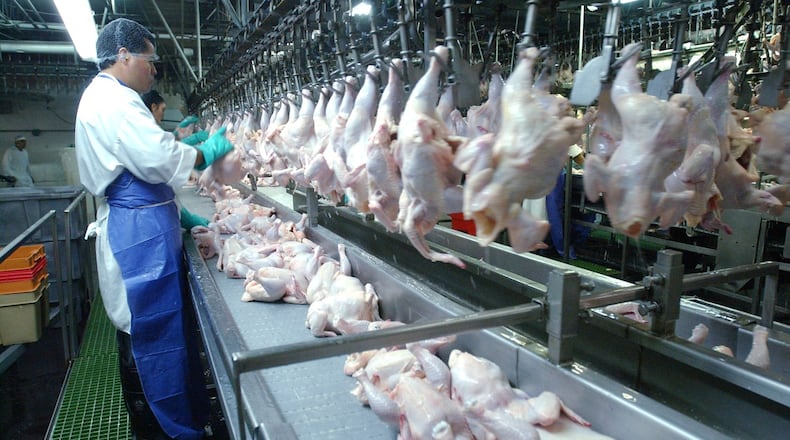America’s appetite for chicken keeps growing. Appetite for working in a chicken plant is another story.
Processors in Georgia’s $4 billion poultry industry — the largest in the country — say they are grappling with a labor shortage that is contributing to falling inventories and rising prices for consumers.
The Wayne Farms chicken processing facility in Pendergrass, about 55 miles north of Atlanta off I-85, says it had 200 openings on its production line in the first week of May, but that fewer than five people applied for jobs. It’s the same at nine other Wayne Farms plants scattered across the Southeast, with about one in four production positions begging for a worker, according to company spokesman Frank Singleton.
Fieldale Farms, a poultry company about 15 miles from Pendergrass, said it’s 1,000 workers short.
“We have have 3,700. We should have 4,700. It’s the worst it’s ever been,” said Tom Hensley, Fieldale’s president.
Poultry processors say a big part of the problem is the federal unemployment benefits that have been disbursed during the pandemic, keeping potential workers on the sidelines. It’s a view shared by employers in other industries as many struggle to rehire enough workers after laying off hundreds of thousands of Georgians earlier in the pandemic.
Gov. Brian Kemp announced late last week that Georgia will halt the $300 weekly federal supplements for unemployed workers on June 26. Labor Commissioner Mark Butler said earlier this month that Georgia will require again that the more than 200,000 recipients of state jobless benefits prove they are applying for jobs, a requirement that has been suspended during the pandemic.
Economists say other forces also are keeping people out of the workforce, such as parents staying home to care for children who are still learning remotely. Many would-be workers are still concerned about their safety in a state where most people still aren’t fully vaccinated. That suggests it could take more time to emerge from a health-based economic crisis that disproportionately affected blue-collar workers.
The poultry industry faces unique challenges after COVID-19 struck at nearly every level of agricultural production because of its dependence on manual labor. Some chicken-processing facilities closed out of health concerns for assembly line workers, some of whom died. Then production slowed as meat processors figured out how to work under new safety guidelines.
At the same time, demand for chicken increased — grocery store sales for wings rose most, up 38% in 2020, U.S. Department of Agriculture figures say. Then, in February 2021, a storm hit Texas, the No. 2 poultry producer behind Georgia, shutting down operations for about a week and causing the deaths of hundreds of thousands of birds.
Frozen U.S. chicken stocks are at their lowest point in four years. They dropped from more than 800 million pounds in January — down about 100 million pounds from the previous three Januarys — to less than 750 million pounds in March, according to the USDA. Certain cut like wings have had spot shortages.
Low supplies are pushing prices higher. The cost for whole chickens in April was up 90% from a year ago. Prices for wings set a record at $2.92 a pound, 180% higher than early 2020.
Atlanta based Chik-fil-A says it has not run out of meat, though it has reported sauce shortages because of supply chain problems.
Hattie B’s, the Nashville hot chicken chain with a restaurant in Atlanta, has not had meat shortages, though it is paying more. “We are just absorbing that for now and plugging away,” said executive chef Brian Morris.
Finding workers to come back to poultry plants hasn’t been easy, even as area employers in recent weeks have offered hiring bonuses and higher wages. Georgia typically employs about 30,000 in bird processing.
It is not easy work. Employees are on their feet and in 40-degree temperatures to keep meat fresh. They work with carcasses and among body fluids and disinfectants, performing repetitious motions with sharp tools while processing more than 100 birds per minute. It has always been a challenge to keep a production line fully staffed.
“I can imagine there are some unwelcoming characteristics of a food-processing plant,” such as noise and smells, said Thomas Smith, an economist at Emory’s Goizueta Business School, who has worked with farmers in Wisconsin.
The work can also be dangerous. Six poultry workers died in a Gainesville plant in January from a leak of liquid nitrogen.
Smith said women who are primary caregivers for children have had a harder time returning to the workforce than men. Nationally, about 40% of poultry processing workers are women, according to an Economic Policy Institute study.
The poultry industry in north Georgia is also heavily dependent on immigrant workers, mostly Latino. Deportations of immigrants without legal papers increased in some counties during President Donald Trump’s tenure. Immigration raids at Mississippi poultry plants in 2019 caused an exodus of workers around Gainesville, the Georgia city dubbed “The Poultry Capital of the World.”
Wayne Farms recently began offering sign-up bonuses of $500, with additional retention bonuses of $500 after both the 60- and 90-day marks. It offers $2 an hour bonuses for employees who have superior attendance, which can boost pay to the $16 an hour mark, Singleton said.
Singleton blamed in part federal unemployment money, which he said “is a diversion for people who feel like they are not going to have to go work.”
State jobless benefits pay up to $365 a week while the federal incentive adds $300 weekly. That’s the equivalent of $16.63 an hour.
Hensley, at Fieldale Farms, estimated the average hourly pay in the industry is about $14 an hour, but companies like his include benefits such as health insurance and a 401k match.
There is also new competition in Georgia for blue-collar workers, especially along I-85 and near metro Atlanta, which has added thousands of labor jobs, such as warehouse workers. Amazon alone now employs more than 21,000 Georgia workers, including four warehouse and distribution centers in nearby Buford and along I-85 that typically employ up to 1,000 workers each. Amazon also is offering $1,000 new-hire bonuses in the Atlanta area and has committed to paying workers $15 an hour, as has fast food chain Chipotle.
“These companies are going to realize it’s difficult to get all the employees they want unless they offer a higher wage,” said Smith, the Emory economist.
About the Author
Keep Reading
The Latest
Featured





